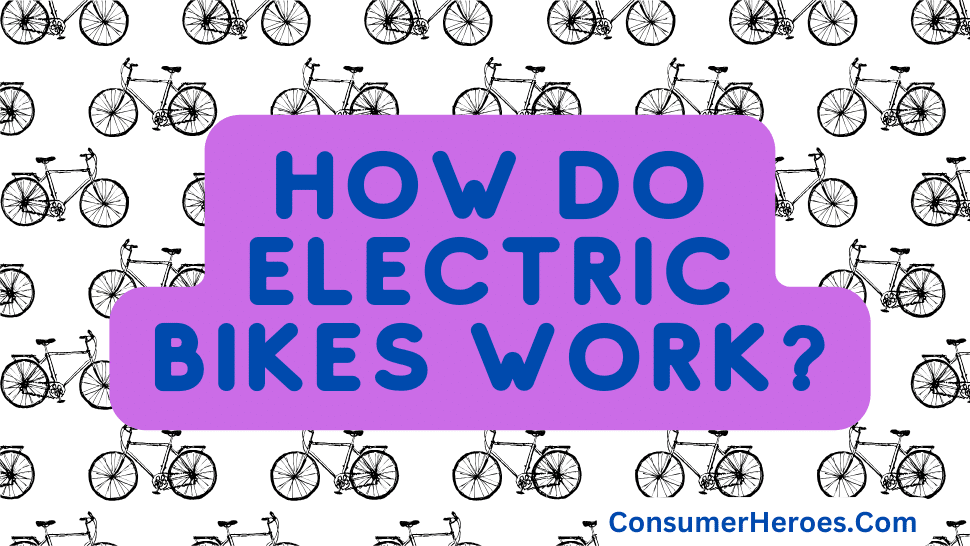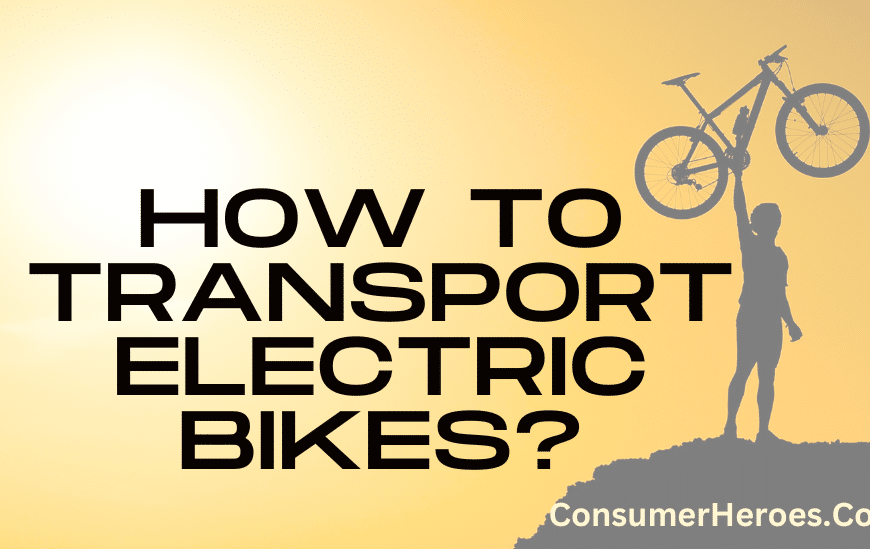Electric bikes, also known as e-bikes, have gained popularity in recent years as a means of transportation and recreation. They are essentially bicycles that are equipped with an electric motor and a battery, which allows riders to travel longer distances and tackle hills and inclines with ease. But how do electric bikes work?
At their most basic level, electric bikes work by combining human power with the power of an electric motor. The motor is typically located in the hub of the bike’s rear wheel or in the crankshaft, and is powered by a battery that is usually mounted on the frame. When the rider pedals, the motor kicks in and provides additional power to propel the bike forward.
The amount of assistance provided by the electric motor can be adjusted by the rider, either through a control on the handlebars or through a smartphone app. Some electric bikes also have sensors that detect how hard the rider is pedaling, and adjust the motor’s output accordingly. With this basic understanding of how electric bikes work, let’s dive deeper into the components and technology that make them possible.
The Basic Principle of Electric Bikes
Electric bikes, also known as e-bikes, are bicycles that are powered by an electric motor. The motor is powered by a battery that is usually located on the frame of the bike. The basic principle of electric bikes is to assist the rider when pedaling, making it easier to ride uphill or against a headwind.
The electric motor is activated by a control system that is typically mounted on the handlebars of the bike. The control system allows the rider to adjust the level of assistance provided by the motor. This can range from no assistance at all, to a full motor-powered ride.
The motor is typically located in the hub of the rear wheel, although it can also be located in the front wheel or the bottom bracket of the bike. The battery is usually located on the frame of the bike, either in the downtube or the rear rack.
When the rider pedals, the motor senses the movement and provides assistance accordingly. The amount of assistance provided by the motor is determined by the level selected on the control system. As the rider pedals harder, the motor provides more assistance, and as the rider pedals less, the motor provides less assistance.
Overall, the basic principle of electric bikes is to provide assistance to the rider, making it easier to ride uphill or against a headwind. The motor and battery work together to provide this assistance, with the control system allowing the rider to adjust the level of assistance provided.
Key Components of Electric Bikes
Electric bikes, also known as e-bikes, are becoming increasingly popular due to their convenience and eco-friendliness. They are essentially regular bicycles with an electric motor and battery attached to provide assistance to the rider. In this section, we will discuss the key components of electric bikes.
Motor
The motor is the heart of the electric bike. It is what provides the power to the wheels and assists the rider in pedaling. There are two main types of motors used in electric bikes: hub motors and mid-drive motors.
- Hub motors are located in the center of either the front or rear wheel and provide direct power to the wheel. They are generally less expensive and easier to maintain than mid-drive motors, but they can make the bike feel unbalanced and affect the handling.
- Mid-drive motors are located near the pedals and provide power to the chain, which in turn powers the wheels. They offer better balance and handling, as well as more efficient power delivery, but they are generally more expensive and require more maintenance.
Battery
The battery is what powers the motor and provides the assistance to the rider. It is usually located on the frame of the bike, either on the downtube or the rear rack. The battery capacity is measured in watt-hours (Wh), and the higher the capacity, the longer the bike can go on a single charge. Most e-bikes have a range of 20-50 miles on a single charge, depending on the battery capacity and the level of assistance used.
Controller
The controller is what regulates the power output from the battery to the motor. It is usually located near the battery and is responsible for controlling the speed and power of the motor. The controller can also provide information such as battery level and speed to the rider through a display or app.
Throttle
The throttle is what allows the rider to control the speed of the bike without pedaling. It is usually located on the handlebars and can be twisted like a motorcycle throttle or pressed like a button. The throttle can provide full power to the motor or a variable level of assistance, depending on the type of e-bike.
Pedal Assist System
The pedal assist system is what makes e-bikes unique. It provides assistance to the rider when they are pedaling, making it easier to climb hills and ride longer distances. The level of assistance can be adjusted through the controller or a display on the handlebars. Most e-bikes have several levels of assistance, ranging from low to high.
In conclusion, the key components of electric bikes are the motor, battery, controller, throttle, and pedal assist system. Each component plays an important role in providing a smooth and efficient riding experience.
Types of Electric Bikes
Electric bikes come in different types, each designed for specific purposes. Some electric bikes are designed for commuting, while others are designed for off-road adventures. Here are the two main types of electric bikes:
Pedal Assist
Pedal assist electric bikes, also known as pedelecs, are the most common type of electric bikes. These bikes have a motor that provides assistance to the rider when pedaling. The motor is activated when the rider starts pedaling and stops when the rider stops pedaling. Pedal assist electric bikes have sensors that detect the rider’s pedaling speed and the amount of force applied to the pedals. The motor provides assistance based on the rider’s pedaling speed and force.
Pedal assist electric bikes have several advantages over traditional bikes. They make cycling easier, especially when going uphill or against the wind. They also allow riders to travel longer distances without getting tired. Pedal assist electric bikes are also eco-friendly and produce no emissions.
Power on Demand
Power on demand electric bikes, also known as throttle bikes, are electric bikes that have a throttle that controls the motor. The rider does not need to pedal to activate the motor. Instead, the rider can use the throttle to control the speed of the bike. Power on demand electric bikes are similar to motorcycles in terms of how they are controlled.
Power on demand electric bikes are ideal for riders who want to travel long distances without pedaling. They are also great for riders who have difficulty pedaling due to physical limitations. However, power on demand electric bikes are not as eco-friendly as pedal assist electric bikes because they produce emissions.
In conclusion, electric bikes come in different types, each designed for specific purposes. Pedal assist electric bikes are the most common type of electric bikes and are ideal for commuting and off-road adventures. Power on demand electric bikes are great for riders who want to travel long distances without pedaling.
How Electric Bikes are Powered
Electric bikes, also known as e-bikes, are powered by a rechargeable battery that provides assistance to the rider. The battery is typically located on the frame of the bike, and can be removed for charging.
The battery provides power to an electric motor, which is usually located in the hub of the rear wheel or in the bottom bracket of the bike. The motor provides additional torque to the pedals, making it easier for the rider to pedal and providing assistance when going up hills or against headwinds.
The amount of assistance provided by the motor can be adjusted by the rider using a control panel on the handlebars. Some e-bikes also have sensors that detect how hard the rider is pedaling and adjust the assistance accordingly.
The range of an e-bike depends on the size of the battery and the amount of assistance used. Most e-bikes have a range of between 20 and 50 miles on a single charge, although this can vary depending on factors such as the terrain, the rider’s weight, and the amount of assistance used.
Overall, e-bikes provide a convenient and eco-friendly way to get around, with the electric motor providing assistance when needed and the rider still getting exercise from pedaling.
The Role of Gears in Electric Bikes
Gears play a crucial role in electric bikes, just as they do in traditional bicycles. They allow the rider to adjust the amount of force needed to pedal, making it easier to ride uphill or faster on flat terrain.
Most electric bikes come equipped with several gears, typically ranging from 7 to 21. The gears are located on the rear wheel, and the rider can shift between them using a shifter located on the handlebars.
When riding an electric bike, the rider can choose a gear that matches their pedaling speed and the terrain they are riding on. For example, if the rider is going uphill, they can shift to a lower gear, which will make it easier to pedal and maintain a consistent speed. Conversely, if the rider is on a flat road, they can shift to a higher gear, which will allow them to pedal less and go faster.
In addition to making it easier to ride, gears also help to extend the range of an electric bike. By adjusting the gear ratio, the rider can reduce the amount of power needed from the electric motor, which can help to conserve battery life.
Overall, the gears on an electric bike are an essential component that allows riders to adjust their pedaling effort and conserve battery power, making it easier and more efficient to ride.
Battery Life and Charging
Electric bikes rely on rechargeable batteries to power their motors. The battery life of an electric bike can vary greatly depending on factors such as the size of the battery, the power of the motor, the terrain being ridden on, and the weight of the rider. On average, a fully charged battery can provide anywhere from 20 to 80 miles of riding distance.
To extend the battery life of an electric bike, riders can take steps such as pedaling more and using the motor less, avoiding steep inclines, and keeping the tires properly inflated. Riders can also invest in a larger battery or carry a spare battery for longer rides.
Charging an electric bike battery is a simple process. Most electric bikes come with a charger that plugs into a standard electrical outlet. The charging time can vary depending on the size of the battery and the charger, but it typically takes around 4-6 hours to fully charge a battery.
Some electric bikes also have the option of charging their batteries while riding. This is known as regenerative braking, which uses the energy generated by braking to recharge the battery. While regenerative braking can help extend the battery life, it is not a substitute for charging the battery fully.
Overall, understanding battery life and charging is an important aspect of owning and operating an electric bike. By taking proper care of the battery and charging it regularly, riders can enjoy longer and more reliable rides.
Safety Features of Electric Bikes
Electric bikes come with various safety features that ensure the rider’s safety and protect them from accidents. Here are some of the most common safety features found in electric bikes:
1. Brakes
Electric bikes come with two types of brakes: mechanical and hydraulic. Mechanical brakes are the most common type and are operated by cables. Hydraulic brakes, on the other hand, use fluid to transfer force from the brake lever to the brake pads. Both types of brakes are effective and reliable, but hydraulic brakes offer better stopping power.
2. Lights
Electric bikes are equipped with lights that ensure the rider’s visibility in low-light conditions. Most electric bikes have a headlight and a taillight, and some models even have additional lights on the handlebars or the frame.
3. Horns and Bells
Electric bikes come with horns or bells that the rider can use to alert pedestrians and other cyclists of their presence. This is especially important when riding in crowded areas or on bike paths.
4. Reflectors
Electric bikes have reflectors on the front, rear, and sides of the bike. These reflectors increase the rider’s visibility to other road users, especially at night.
5. Speed Limiters
Most electric bikes come with speed limiters that prevent the bike from going over a certain speed. This is an important safety feature, especially for novice riders who may not be used to the speed and power of electric bikes.
Overall, electric bikes are designed with safety in mind, and the features listed above ensure that riders can enjoy their bikes while minimizing the risk of accidents.
Environmental Impact of Electric Bikes
Electric bikes have many advantages over traditional bicycles and gas-powered vehicles, including their positive impact on the environment. Here are a few ways that electric bikes are environmentally friendly:
- Reduced Emissions: Electric bikes produce zero emissions. They run on batteries that are charged by electricity, which can be generated from renewable sources like solar and wind power. This means that electric bikes do not contribute to air pollution or greenhouse gas emissions, making them an excellent option for people who want to reduce their carbon footprint.
- Less Noise Pollution: Electric bikes are much quieter than gas-powered vehicles, which means they produce less noise pollution. This can be especially important in urban areas where noise pollution can be a significant problem.
- Less Land Use: Electric bikes require much less land use than cars or other vehicles. They do not require parking lots or gas stations, which can take up a lot of space in urban areas. This can help reduce urban sprawl and preserve natural areas.
- Less Congestion: Electric bikes can help reduce traffic congestion in urban areas. They can be used in bike lanes and on bike paths, which can help reduce the number of cars on the road and make traffic flow more smoothly.
Overall, electric bikes are an excellent option for people who want to reduce their impact on the environment. They produce zero emissions, require less land use, and can help reduce traffic congestion and noise pollution.
Conclusion
Electric bikes are an innovative and eco-friendly mode of transportation that are growing in popularity. They use a combination of a battery-powered motor and pedals to provide a smooth and efficient ride. The motor can be controlled by a throttle or by pedaling, depending on the bike’s design.
One of the biggest advantages of electric bikes is their ability to provide a boost to riders who may not be able to pedal up hills or for long distances. This makes them ideal for commuters, casual riders, and even those who want to use them for exercise.
Another advantage is that they are relatively low-maintenance compared to traditional bikes. With fewer moving parts and no need for gas or oil changes, electric bikes are a cost-effective and convenient option for those looking to reduce their carbon footprint.
It is important to note that not all electric bikes are created equal. Different models will have different motor sizes, battery capacities, and ranges. It is important to do research and test ride different options to find the right electric bike for your needs.
Overall, electric bikes offer a fun and practical alternative to traditional bikes and cars. With their growing popularity and advancements in technology, they are sure to become an even more common sight on the roadways in the future.







